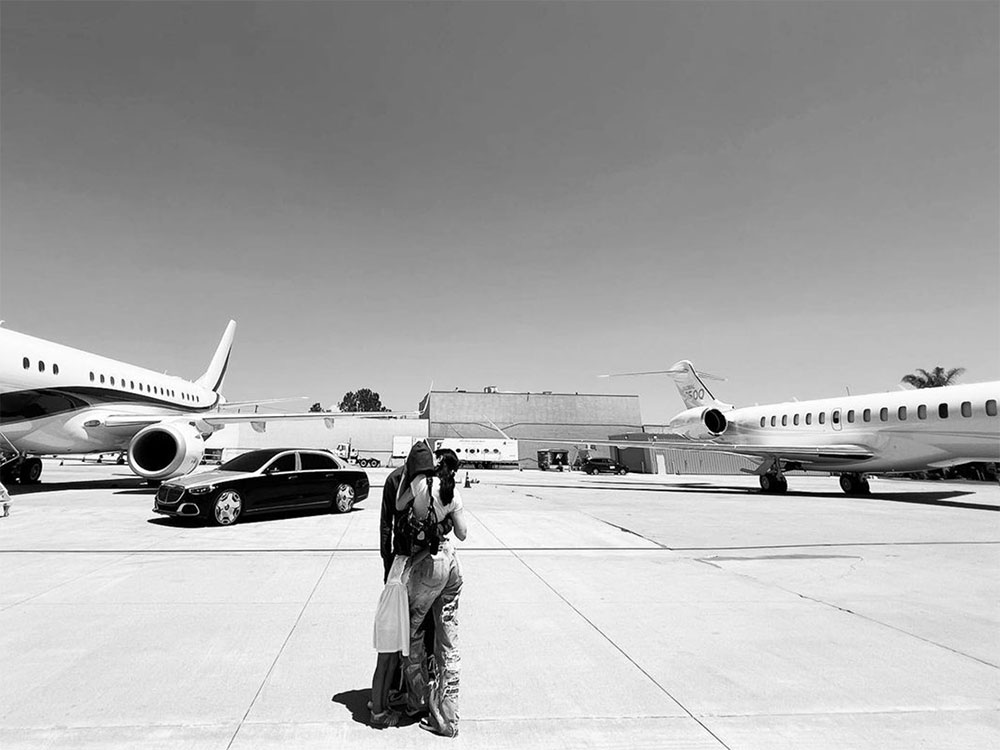I just turned 24. It’s a great age to start figuring out your priorities: Where do I want to set down roots? Do I want children? And importantly, will there be a world left for said children?
I try not to dwell on my climate anxiety because the more I think about it, the grimmer the future looks. A glimpse into the lives of others as they play out on social media provides a sound distraction from the world that’s burning around me and the helplessness I feel. And though I wouldn’t consider myself influenced by the lives of any social media influencer or celebrity, I do feel the need to keep my finger on the pulse of pop culture.
So when Kylie Jenner made a now-infamous Instagram post featuring herself and her partner Travis Scott, I immediately took an interest because it held so much of what is appealing about pop culture: it’s simultaneously banal and extraordinary in its documentation of everyday life. For Jenner, it was just a regular Friday.
The post, a black-and-white photo of Jenner and Scott embracing on the tarmac between two airplanes, included the caption, “You wanna take mine or yours?” The pair was boarding a 12-minute flight from Van Nuys, a neighbourhood of Los Angeles, to Camarillo, a city in Ventura County, California. They travelled about 59 kilometres, which would have taken under an hour to drive.
The July 15 post now has over 8 million likes on Instagram. The online criticism about her flight continues to fan out on Twitter. Comments range from calling her a “full-time climate criminal” to asking “Why is this still legal?”
In 2019, at the age of 23, Jenner was recognized as the world’s youngest self-made billionaire. She accumulated her wealth through her family’s hit reality TV show, Keeping Up with the Kardashians, and her beauty and cosmetic empire, Kylie Cosmetics. The controversy around her short flight out of L.A. brought to light similar short flights taken by celebrities like Floyd Mayweather, Drake, Mark Wahlberg, Elon Musk, Kim Kardashian and many more. Most recently, Taylor Swift was called out for chartering 170 flights just this year.
The average person living in North America produces something over 13 tonnes of CO2 annually. But a single private jet produces around 1.81 tonnes of CO2 emissions in an hour.
In case you’re wondering, all air travel makes up 2.5 per cent of total global emissions. And as polluting as most air travel is, private jets are particularly gross — producing five to 14 times more emissions than commercial planes per passenger and collectively around 30 million tonnes of greenhouse gases per year — more than the annual emissions of Denmark.
So it’s not news that as carbon emissions and greenhouse gases soar, the scales of climate conservation hope tip against us.
We’re down to the wire.
In fact, current modelling for how climate change will impact us may have strongly underestimated both the pace and the strength of climate change, considering the striking ice melt and varied temperature increases we’re grappling with today, according to David Hunter, a professor of environmental law and policy at American University’s Washington College of Law.
Which means we need to be asking ourselves some very basic questions about how to reinvent our vision of the good life. Let’s assume it not only excludes private jets but most commercial air travel as well.
“We need an equitable and fair and complete transition as soon as possible to fossil-free energy sources,” Hunter told The Tyee. “I think we’re getting to the point where we’re going to have to start talking about either new technologies or massive ways of taking carbon out of the atmosphere.”
By some estimates, fossil fuels burned by the global business and travel industry amount to a fifth (approximately 24 per cent) of global energy consumption and emissions. So what would big cuts to that sector look like?
Well, we may have glimpsed the future, and it wasn’t so bad. The beginning of the COVID-19 pandemic in 2020 saw a drastic reduction in mobility including travel by road, air, sea and rail, which takes up around 57 per cent of global oil demand, according to the International Energy Agency. Then, spurred on by ad blitzes extolling globe-trotting holidays, emission levels rebounded by six per cent last year, and 2022 has seen emission activities across the globe increase with a vengeance.
So the question for you and me is this. Can we resist the allure of each having our own little moments of celebrity lifestyles, so relentlessly modelled by Kylie Jenner and her ilk?
Why we can’t let celebs off the hook
Katherine White, a University of British Columbia professor and expert in consumer insights, prosocial consumption and sustainability, describes what we’re up against.
“One of the ways we infer what the social norm is if we look at the behaviours of other people,” White told The Tyee. “If we see lots of people engaging in a behaviour, we often will infer that this is kind of normative, this is appropriate, and this is the right thing to be doing in this context.”
A deep dive into Kylie Jenner’s flight also brought to light some repeat offenders and a barrage of internet comments that surprisingly defended these extravagant, unnecessary carbon emissions by celebrities. Which led me to wonder if the fans of these celebrities are so taken by their star power that they can’t compute the long-term ecological consequences of their actions on the planet that we all call home.
Where’s the revolution when the have-nots don’t see the problem with their station and how excess at the top impacts their daily lives? We see this juxtaposition play out often in my own backyard, Vancouver, one of the most expensive cities in the world. A one-bedroom apartment can sell for a cool $1 million, but many people my age struggle to afford the monthly rent for an apartment in the city even with full-time jobs.
When celebrities like Kim Kardashian make statements like "nobody wants to work these days" while sitting in her Calabasas mansion bought with wealth afforded to her by nepotism, there’s much to consider about the type of influence celebrities like her wield and whether they even should.
“And so if you were a person who follows a bunch of celebrities [on social media], and they're living these celebrity lifestyles, and they're engaging in very luxurious and carbon-intensive behaviours, the social norm could be perceived to be ‘okay, this is what everybody is doing’ and this is totally appropriate,” White tells me.
“Jet setting might incentivize more air travel,” White adds. “Maybe that’s not the most sustainable option.”
The bigger takeaway: While it may feel like a harmless pleasure to live vicariously via jet-setting celebs, they are called influencers for a reason. Maybe part of any real agenda to fight climate change means seriously changing our media diets.
A drop in the ocean
Of course, other celebrities send a different, more helpful message, even as they live their mega-sized lives while soaking up lots of attention on social media. In early 2022, actor Ryan Reynolds and his partner Blake Lively made a $500,000 contribution to Water First Education and Training, a charitable organization in Ontario that addresses water challenges in Indigenous communities. Others, like actor Jane Fonda, have been active advocates and participated in civil disobedience for climate action.
But individual actions like these are but a drop in an ocean if not complemented with robust legislative reforms and policies. At home, Canada hopes to achieve net-zero emissions by 2050 and has implemented a carbon tax through a federal carbon pricing system that will rise steeply from its current level of $50 per tonne of emissions to $170 by 2030 in order to push consumers toward cleaner energy sources. The federal government also incentivizes a switch to electric automobiles with purchase incentives up to $5,000.
“I have some hope. It’s this combination of a signal that’s being sent by the countries through the Paris Agreement that carbon is dead as a future and that innovation is humanity,” David Hunter told me. “And there’s some beauty in the decentralized solar and decentralized wind which can be totally valuable for social equity purposes.”
The larger conversations around climate change and carbon emissions also need to shift from a per country perspective to a per capita one that accounts for disproportionate inequity in consumption levels. Especially when you consider that the global average for CO2 emissions per capita is 4.4 tonnes.
First-world countries like Canada, the United States and Europe need to turn the lens of scrutiny inward, especially since they’re home to some of the biggest contributors to emissions on an individual and industrial scale.
Investing in clean energy and encouraging the redistribution of excess wealth to the research and development of clean technology for jets and industries will be key to ensuring there is a world to leave behind for the next generation.
As for me, Kylie Jenner and her ilk will serve as a constant reminder that the rich can have their cake and eat it too and that there’s nothing remotely aspirational about their lifestyle.
Not just because they can buy a one-way ticket to Elon Musk’s space colony after wreaking havoc on our planet’s ecosystem, but also because their lack of accountability is validated by the awareness that they have the means to insulate themselves from the harshest impacts of climate change. Investing in infrastructure capable of withstanding extreme heat and cold, and migrating to places with hospitable weather are easy fixes in their world. To millions of others, these will be the defining problems of their lifetimes.
I’m also becoming aware that the existing power structures and economic systems not only support the rich, but enable them to step on the backs of those less fortunate — even and especially if their lives appear beautiful in curated, photoshopped Instagram posts.
In an economy that gentrifies neighbourhoods and pushes young people unable to afford million-dollar houses to the edges of bustling cities, home ownership is an unachievable dream for many people in their 20s and 30s. So is having your own family and children. Because what kind of world are we leaving behind for them? ![]()
Read more: Travel, Transportation, Media, Environment

















Tyee Commenting Guidelines
Comments that violate guidelines risk being deleted, and violations may result in a temporary or permanent user ban. Maintain the spirit of good conversation to stay in the discussion.
*Please note The Tyee is not a forum for spreading misinformation about COVID-19, denying its existence or minimizing its risk to public health.
Do:
Do not: